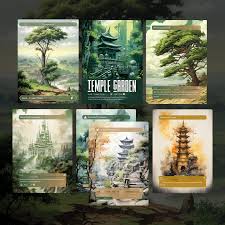The Strategic Role of Fetch Lands in Magic: The Gathering
Fetch lands are a crucial component of deck construction in Magic: The Gathering (MTG), offering players strategic advantages in multicolored decks. These lands can be sacrificed to search the library for a basic land of a specific type, providing mana-fixing, deck-thinning, and synergy with various mechanics. Over the years, fetch lands have evolved, becoming a staple in formats like Modern, Legacy, and Vintage. This article explores the history, functionality, and impact of fetch lands in MTG.
The Origins: Mirage Fetch Lands
Fetch lands first appeared in the Mirage set, marking the beginning of a new era in land design. These lands enter the battlefield tapped and can be sacrificed to search for a land card with at least one of two basic land types of an allied color pair. For example, Flood Plain allows players to fetch a Plains or an Island, which are essential for decks that need access to both white and blue mana. The other lands in this cycle include Bad River (Island/Swamp), Rocky Tar Pit (Swamp/Mountain), Mountain Valley (Mountain/Forest), and Grasslands (Forest/Plains).
Onslaught Fetch Lands: A Game-Changer
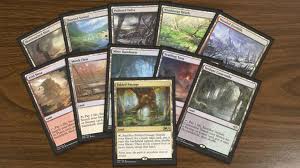
The Onslaught set introduced a new cycle of fetch lands that significantly impacted gameplay. Unlike their Mirage counterparts, these lands enter the battlefield untapped, and players can pay one life to search their library for a land card with one of two basic land types of an allied color pair. The lands in this cycle include Flooded Strand (Plains/Island), Polluted Delta (Island/Swamp), Bloodstained Mire (Swamp/Mountain), Wooded Foothills (Mountain/Forest), and Windswept Heath (Forest/Plains). These lands were so influential that they were later reprinted in Khans of Tarkir, Fate Reforged, and Modern Horizons 3.
The Onslaught fetch lands became a staple in competitive decks, particularly in formats that allowed older cards. Their ability to enter the battlefield untapped made them highly versatile, enabling early game mana-fixing without slowing down the deck.
Zendikar Fetch Lands: Expanding Horizons
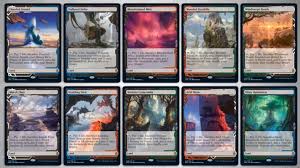
In the Zendikar set, Wizards of the Coast expanded the fetch land cycle to include enemy color pairs. These lands function similarly to the Onslaught fetch lands, allowing players to pay one life to search for a land card with one of two basic land types of an enemy color pair. The cycle includes Marsh Flats (Plains/Swamp), Scalding Tarn (Island/Mountain), Verdant Catacombs (Swamp/Forest), Arid Mesa (Mountain/Plains), and Misty Rainforest (Forest/Island). These lands were reprinted in Modern Masters 2017, Secret Lair: Ultimate Edition, and Modern Horizons 2.
The introduction of enemy color fetch lands provided even more options for deck construction, allowing players to build three- or four-color mana bases with greater consistency. These lands also synergized with mechanics like Landfall, Delve, and Revolt, enhancing the overall gameplay experience.
The Impact of Fetch Lands on Competitive Formats
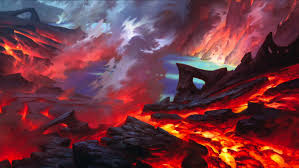
Fetch lands have had a profound impact on the Modern, Legacy, and Vintage formats. Their ability to thin the deck by removing a land card reduces the likelihood of drawing lands in the late game, increasing the chances of drawing more impactful spells. This deck-thinning effect is particularly valuable in formats where every draw counts.
In combination with shock lands, fetch lands enable the construction of three- or four-color mana bases at the cost of a few life points. The flexibility they offer has led to their widespread use, with many competitive decks running as many as twelve fetch lands alongside other mana-producing lands.
However, the widespread use of fetch lands has also introduced challenges. The need to shuffle the deck after each fetch land activation slows down gameplay, leading to longer games and increased complexity. Additionally, the power of fetch lands contributed to their ban in the Pioneer format, where Wizards of the Coast sought to create a more balanced and accessible non-rotating format.
The Evolution of Fetch Lands: Shards of Alara and Beyond
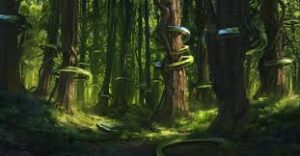
The design space for fetch lands continued to evolve with the release of Shards of Alara, which introduced Panoramas. These lands allowed players to search for one of three basic land types of a shard but required additional mana to activate. For example, Esper Panorama could search for a Plains, Island, or Swamp, representing the colors of the Esper shard.
More recently, the Streets of New Capenna set introduced a new cycle of fetch lands that sacrifice themselves upon entering the battlefield to gain life and fetch a basic land in one of the colors of the five families. Unlike traditional fetch lands, these lands have no activated ability, reflecting a different approach to land design.
The latest evolution came in Modern Horizons 3, which introduced three-color fetch lands that can be sacrificed for free and cycled for their three representative colors. These lands, such as Contaminated Landscape (Plains/Island/Swamp) and Seething Landscape (Island/Swamp/Mountain), offer even greater versatility in deck construction, particularly in formats with diverse mana requirements.
Conclusion: The Legacy of Fetch Lands
Fetch lands have become an integral part of MTG’s competitive landscape, shaping deck construction and gameplay strategies for over two decades. Their ability to provide mana-fixing, deck-thinning, and synergy with various mechanics makes them invaluable in multicolored decks. As the game continues to evolve, fetch lands will undoubtedly remain a cornerstone of strategic play, influencing both current and future formats. Whether you’re a seasoned player or new to the game, understanding the role of fetch lands is essential for mastering the art of deckbuilding in Magic: The Gathering.


